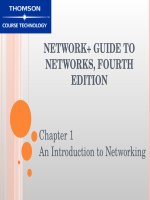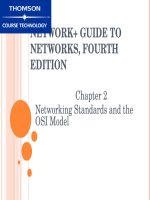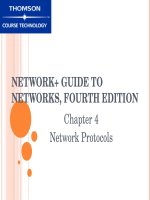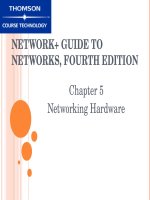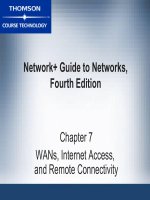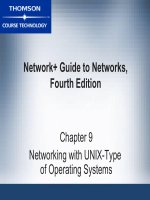NETWORK+ GUIDE TO NETWORKS, FOURTH EDITION - CHAPTER 1 potx
Bạn đang xem bản rút gọn của tài liệu. Xem và tải ngay bản đầy đủ của tài liệu tại đây (447.52 KB, 30 trang )
NETWORK+ GUIDE TO
NETWORKS, FOURTH
EDITION
Chapter 1
An Introduction to Networking
OBJECTIVES
List the advantages of networked computing
relative to standalone computing
Distinguish between client/server and peer-to-
peer networks
List elements common to all client/server
networks
Describe several specific uses for a network
Identify some of the certifications available to
networking professionals
Identify the kinds of nontechnical, or “soft,” skills
that will help you succeed as a networking
professional
2
N
e
t
w
o
r
k
+
G
u
i
d
e
t
o
N
e
t
w
o
r
k
s
,
4
e
WHY USE NETWORKS?
Network: group of computers and other devices
that are connected by some type of transmission
data.
Advantages of using networks over standalone
computers:
Networks enable multiple users to share the
network’s resources (devices and data)
Networks allow you to manage, or administer,
resources on multiple computers from a central
location
3
N
e
t
w
o
r
k
+
G
u
i
d
e
t
o
N
e
t
w
o
r
k
s
,
4
e
TYPES OF NETWORKS:
PEER-TO-PEER NETWORKS
Every computer can communicate directly with
every other computer
By default, no computer has more authority than
another
Every computer is capable of sending and
receiving information to and from every other
computer
4
N
e
t
w
o
r
k
+
G
u
i
d
e
t
o
N
e
t
w
o
r
k
s
,
4
e
PEER-TO-PEER NETWORKS
(CONTINUED)
5
N
e
t
w
o
r
k
+
G
u
i
d
e
t
o
N
e
t
w
o
r
k
s
,
4
e
Figure 1-1: Resource sharing on a simple peer-to-peer network
CLIENT/SERVER NETWORKS
Server: central computer used to facilitate
communication and resource sharing between
other computers on the network (called clients)
Client/server network: uses a server to enable
clients to share data, data storage space, and
devices
To function as a server, a computer must be
running a network operating system (NOS)
Most of the concepts on the Network+ exam
pertain to client/server networks
6
N
e
t
w
o
r
k
+
G
u
i
d
e
t
o
N
e
t
w
o
r
k
s
,
4
e
CLIENT/SERVER NETWORKS
(CONTINUED)
7
N
e
t
w
o
r
k
+
G
u
i
d
e
t
o
N
e
t
w
o
r
k
s
,
4
e
Figure 1-2: Resource sharing on a client/server network
CLIENT/SERVER NETWORKS
(CONTINUED)
Advantages of using client/server networks over peer-
to-peer networks:
User logon accounts and passwords can be assigned in one
place
Access to multiple shared resources can be centrally
granted to a single user or groups of users
Problems can be tracked, diagnosed, and often fixed from
one location.
8
N
e
t
w
o
r
k
+
G
u
i
d
e
t
o
N
e
t
w
o
r
k
s
,
4
e
CLIENT/SERVER NETWORKS
(CONTINUED)
Advantages of using client/server networks over peer-to-peer
networks (continued):
Servers are optimized to handle heavy processing loads and
dedicated to handling requests from clients, enabling faster
response time
Because of their efficient processing and larger disk storage,
servers can connect more than a handful of computers on a
network
9
N
e
t
w
o
r
k
+
G
u
i
d
e
t
o
N
e
t
w
o
r
k
s
,
4
e
LANS, MANS, AND WANS
Local area network (LAN): confine to a relatively
small space, such as a building or an office
Metropolitan area network (MAN): larger than a
LAN; connects clients and servers from multiple
buildings
Wide area network (WAN): connects two or more
geographically distinct LANs or MANs
10
N
e
t
w
o
r
k
+
G
u
i
d
e
t
o
N
e
t
w
o
r
k
s
,
4
e
LANS, MANS, AND WANS
(CONTINUED)
11
N
e
t
w
o
r
k
+
G
u
i
d
e
t
o
N
e
t
w
o
r
k
s
,
4
e
Figure 1-4: A simple WAN
ELEMENTS COMMON TO
CLIENT/SERVER NETWORKS
Client.
Server.
Workstation.
Network interface card (NIC).
NOS (Network Operating System)
Host (network devices, PC, printer, )
Node.
Connectivity device: switch, router,
12
N
e
t
w
o
r
k
+
G
u
i
d
e
t
o
N
e
t
w
o
r
k
s
,
4
e
ELEMENTS COMMON TO
CLIENT/SERVER NETWORKS
(CONTINUED)
13
N
e
t
w
o
r
k
+
G
u
i
d
e
t
o
N
e
t
w
o
r
k
s
,
4
e
Figure 1-5: A NIC
ELEMENTS COMMON TO
CLIENT/SERVER NETWORKS
(CONTINUED)
Segment.
Backbone.
Topology.
Protoco.
Data packets.
Addressing.
Transmission media.
14
N
e
t
w
o
r
k
+
G
u
i
d
e
t
o
N
e
t
w
o
r
k
s
,
4
e
ELEMENTS COMMON TO
CLIENT/SERVER NETWORKS
(CONTINUED)
15
N
e
t
w
o
r
k
+
G
u
i
d
e
t
o
N
e
t
w
o
r
k
s
,
4
e
Figure 1-6: A LAN backbone
ELEMENTS COMMON TO
CLIENT/SERVER NETWORKS
(CONTINUED)
16
N
e
t
w
o
r
k
+
G
u
i
d
e
t
o
N
e
t
w
o
r
k
s
,
4
e
Figure 1-7: Common network topologies
ELEMENTS COMMON TO
CLIENT/SERVER NETWORKS
(CONTINUED)
17
N
e
t
w
o
r
k
+
G
u
i
d
e
t
o
N
e
t
w
o
r
k
s
,
4
e
Figure 1-8: Examples of network transmission media
HOW NETWORKS ARE USED
Network services: functions provided by a network
File services
Capability of a server to share data files, applications, and
disk storage space
File server
Print services: used to share printers across a
network
18
N
e
t
w
o
r
k
+
G
u
i
d
e
t
o
N
e
t
w
o
r
k
s
,
4
e
HOW NETWORKS ARE USED
(CONTINUED)
Communications services
Allow remote users to connect to the network
Remote access server (also known as communications
server or access server)
Mail services
Co-ordinate the storage and transfer of e-mail
between users on a network
Mail server
19
N
e
t
w
o
r
k
+
G
u
i
d
e
t
o
N
e
t
w
o
r
k
s
,
4
e
HOW NETWORKS ARE USED
(CONTINUED)
Internet services
Supplying Web pages, file transfer capabilities,
Internet addressing schemes, security filters, and a
means for directly logging on to other computers on
the Internet
Web server
Management services: centrally administer
management tasks on the network
Traffic monitoring and control
Load balancing
20
N
e
t
w
o
r
k
+
G
u
i
d
e
t
o
N
e
t
w
o
r
k
s
,
4
e
HOW NETWORKS ARE USED
(CONTINUED)
Management services (continued)
Hardware diagnosis and failure alert
Asset management (tai san)
License tracking
Security auditing
Software distribution
Address management
Backup and restoration of data
21
N
e
t
w
o
r
k
+
G
u
i
d
e
t
o
N
e
t
w
o
r
k
s
,
4
e
BECOMING A NETWORKING
PROFESSIONAL: MASTERING THE
TECHNICAL CHALLENGES
Installing, configuring, and troubleshooting
network server software and hardware
Installing, configuring, and troubleshooting
network client software and hardware
Understanding the characteristics of different
transmission media
Understanding network design
22
N
e
t
w
o
r
k
+
G
u
i
d
e
t
o
N
e
t
w
o
r
k
s
,
4
e
MASTERING THE TECHNICAL
CHALLENGES (CONTINUED)
Understanding network protocols
Understanding how users interact with the
network
Constructing a network with clients, servers,
media, and connectivity devices
23
N
e
t
w
o
r
k
+
G
u
i
d
e
t
o
N
e
t
w
o
r
k
s
,
4
e
PURSUING CERTIFICATION
Certification: process of mastering material
pertaining to a particular hardware system,
operating system (OS), programming language, or
other software application, and then proving your
mastery by passing a series of exams
A+
Microsoft Certified Systems Engineer (MCSE)
Certified NetWare Engineer (CNE)
Network+ (Net+)
24
N
e
t
w
o
r
k
+
G
u
i
d
e
t
o
N
e
t
w
o
r
k
s
,
4
e
FINDING A JOB IN NETWORKING
Search the Web
Read the newspaper
Visit a career center
Network
Attend career fairs
Enlist a recruiter
25
N
e
t
w
o
r
k
+
G
u
i
d
e
t
o
N
e
t
w
o
r
k
s
,
4
e
